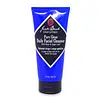What's inside
What's inside
 Key Ingredients
Key Ingredients

No key ingredients
 Benefits
Benefits

 Concerns
Concerns

 Ingredients Side-by-side
Ingredients Side-by-side

Water
Skin ConditioningKaolin
AbrasiveGlycerin
HumectantSodium Methyl Cocoyl Taurate
CleansingMagnesium Aluminum Silicate
AbsorbentVolcanic Ash
AbrasiveAvena Sativa Kernel Meal
AbrasiveSodium Chloride
MaskingAcrylates Copolymer
Glycolic Acid
BufferingArnica Montana Flower Extract
MaskingRosmarinus Officinalis Leaf Extract
AntimicrobialCamellia Sinensis Leaf Extract
AntimicrobialOlea Europaea Leaf Extract
PerfumingAllantoin
Skin ConditioningAloe Barbadensis Leaf Juice
Skin ConditioningPanthenol
Skin ConditioningChamomilla Recutita Flower Extract
MaskingTocopheryl Acetate
AntioxidantHelianthus Annuus Seed Oil
EmollientCalendula Officinalis Flower Extract
MaskingTocopherol
AntioxidantDisodium Cocoamphodiacetate
CleansingCoconut Acid
CleansingPhenoxyethanol
PreservativeCaprylyl Glycol
EmollientSodium Hydroxide
BufferingEthylhexylglycerin
Skin ConditioningHexylene Glycol
EmulsifyingEpilobium Angustifolium Flower/Leaf/Stem Extract
Skin ConditioningTetrahexyldecyl Ascorbate
AntioxidantChlorphenesin
AntimicrobialSodium Metabisulfite
AntioxidantBenzoic Acid
MaskingSorbic Acid
PreservativeWater, Kaolin, Glycerin, Sodium Methyl Cocoyl Taurate, Magnesium Aluminum Silicate, Volcanic Ash, Avena Sativa Kernel Meal, Sodium Chloride, Acrylates Copolymer, Glycolic Acid, Arnica Montana Flower Extract, Rosmarinus Officinalis Leaf Extract, Camellia Sinensis Leaf Extract, Olea Europaea Leaf Extract, Allantoin, Aloe Barbadensis Leaf Juice, Panthenol, Chamomilla Recutita Flower Extract, Tocopheryl Acetate, Helianthus Annuus Seed Oil, Calendula Officinalis Flower Extract, Tocopherol, Disodium Cocoamphodiacetate, Coconut Acid, Phenoxyethanol, Caprylyl Glycol, Sodium Hydroxide, Ethylhexylglycerin, Hexylene Glycol, Epilobium Angustifolium Flower/Leaf/Stem Extract, Tetrahexyldecyl Ascorbate, Chlorphenesin, Sodium Metabisulfite, Benzoic Acid, Sorbic Acid
Water
Skin ConditioningSodium C14-16 Olefin Sulfonate
CleansingDisodium Cocoamphodiacetate
CleansingAloe Barbadensis Leaf Juice
Skin ConditioningCocamidopropyl Betaine
CleansingSodium Lauroyl Oat Amino Acids
CleansingGlycol Distearate
EmollientPEG-150 Distearate
EmulsifyingHamamelis Virginiana Extract
AntiseborrhoeicGlycerin
HumectantLavandula Angustifolia Extract
Skin ConditioningSalvia Officinalis Leaf Extract
CleansingMatricaria Recutita Flower Oil
PerfumingRosmarinus Officinalis Leaf Oil
MaskingSalvia Officinalis Leaf Oil
Lippia Citriodora Oil
PerfumingPEG-8 Dimethicone
EmulsifyingSodium Chloride
MaskingSodium PCA
HumectantCetyl Alcohol
EmollientCitric Acid
BufferingBenzyl Alcohol
PerfumingDehydroacetic Acid
PreservativeWater, Sodium C14-16 Olefin Sulfonate, Disodium Cocoamphodiacetate, Aloe Barbadensis Leaf Juice, Cocamidopropyl Betaine, Sodium Lauroyl Oat Amino Acids, Glycol Distearate, PEG-150 Distearate, Hamamelis Virginiana Extract, Glycerin, Lavandula Angustifolia Extract, Salvia Officinalis Leaf Extract, Matricaria Recutita Flower Oil, Rosmarinus Officinalis Leaf Oil, Salvia Officinalis Leaf Oil, Lippia Citriodora Oil, PEG-8 Dimethicone, Sodium Chloride, Sodium PCA, Cetyl Alcohol, Citric Acid, Benzyl Alcohol, Dehydroacetic Acid
Ingredients Explained
These ingredients are found in both products.
Ingredients higher up in an ingredient list are typically present in a larger amount.
Aloe Barbadensis Leaf Juice comes from leaves of the aloe plant. Aloe Barbadensis Leaf Juice is best known for helping to soothe sunburns. It is also anti-inflammatory, moisturizing, antiseptic, and can help heal wounds.
Aloe is packed with good stuff including Vitamins A, C, and E. These vitamins are antioxidants, which help fight free-radicals and the damage they may cause. Free-radicals are molecules that may damage your skin cells, such as pollution.
Aloe Barbadensis Leaf Juice also contains sugars. These sugars come in the form of monosaccharides and polysaccharides, folic acid, and choline. These sugars are able to help bind moisture to skin.
It also contains minerals such as calcium, 12 anthraquinones, fatty acids, amino acids, and Vitamin B12.
Learn more about Aloe Barbadensis Leaf JuiceDisodium Cocoamphodiacetate is a surfactant and helps cleanse skin. It is created from the fatty acids of coconut oil.
Surfactants help rinse oil, dirt, and other pollutants easily from skin. It has a faint fruit-like scent.
Glycerin is already naturally found in your skin. It helps moisturize and protect your skin.
A study from 2016 found glycerin to be more effective as a humectant than AHAs and hyaluronic acid.
As a humectant, it helps the skin stay hydrated by pulling moisture to your skin. The low molecular weight of glycerin allows it to pull moisture into the deeper layers of your skin.
Hydrated skin improves your skin barrier; Your skin barrier helps protect against irritants and bacteria.
Glycerin has also been found to have antimicrobial and antiviral properties. Due to these properties, glycerin is often used in wound and burn treatments.
In cosmetics, glycerin is usually derived from plants such as soybean or palm. However, it can also be sourced from animals, such as tallow or animal fat.
This ingredient is organic, colorless, odorless, and non-toxic.
Glycerin is the name for this ingredient in American English. British English uses Glycerol/Glycerine.
Learn more about GlycerinChances are, you eat sodium chloride every day. Sodium Chloride is also known as table salt.
This ingredient has many purposes in skincare: thickener, emulsifier, and exfoliator.
You'll most likely find this ingredient in cleansers where it is used to create a gel-like texture. As an emulsifier, it also prevents ingredients from separating.
There is much debate on whether this ingredient is comedogenic. The short answer - comedogenic ratings don't tell the whole story. Learn more about comegodenic ratings here.
The concensus about this ingredient causing acne seems to be divided. Research is needed to understand if this ingredient does cause acne.
Scrubs may use salt as the primary exfoliating ingredient.
Learn more about Sodium ChlorideWater. It's the most common cosmetic ingredient of all. You'll usually see it at the top of ingredient lists, meaning that it makes up the largest part of the product.
So why is it so popular? Water most often acts as a solvent - this means that it helps dissolve other ingredients into the formulation.
You'll also recognize water as that liquid we all need to stay alive. If you see this, drink a glass of water. Stay hydrated!
Learn more about Water